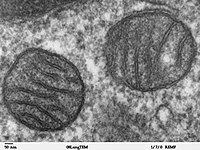
Photo from wikipedia
We report a computational study of mitochondria transport in a branched axon with two branches of different sizes. For comparison, we also investigate mitochondria transport in an axon with symmetric… Click to show full abstract
We report a computational study of mitochondria transport in a branched axon with two branches of different sizes. For comparison, we also investigate mitochondria transport in an axon with symmetric branches and in a straight (unbranched) axon. The interest in understanding mitochondria transport in branched axons is motivated by the large size of arbors of dopaminergic neurons, which die in Parkinson’s disease. Since the failure of energy supply of multiple demand sites located in various axonal branches may be a possible reason for the death of these neurons, we were interested in investigating how branching affects mitochondria transport. Besides investigating mitochondria fluxes between the demand sites and mitochondria concentrations, we also studied how the mean age of mitochondria and mitochondria age densities depend on the distance from the soma. We established that if the axon splits into two branches of unequal length, the mean ages of mitochondria and age density distributions in the demand sites are affected by how the mitochondria flux splits at the branching junction (what portion of mitochondria enter the shorter branch and what portion enter the longer branch). However, if the axon splits into two branches of equal length, the mean ages and age densities of mitochondria are independent of how the mitochondria flux splits at the branching junction. This even holds for the case when all mitochondria enter one branch, which is equivalent to a straight axon. Because the mitochondrial membrane potential (which many researchers view as a proxy for mitochondrial health) decreases with mitochondria age, the independence of mitochondria age on whether the axon is symmetrically branched or straight (providing the two axons are of the same length), and on how the mitochondria flux splits at the branching junction, may explain how dopaminergic neurons can sustain very large arbors and still maintain mitochondrial health across branch extremities.
Journal Title: International Journal for Numerical Methods in Biomedical Engineering
Year Published: 2022
Link to full text (if available)
Share on Social Media: Sign Up to like & get
recommendations!